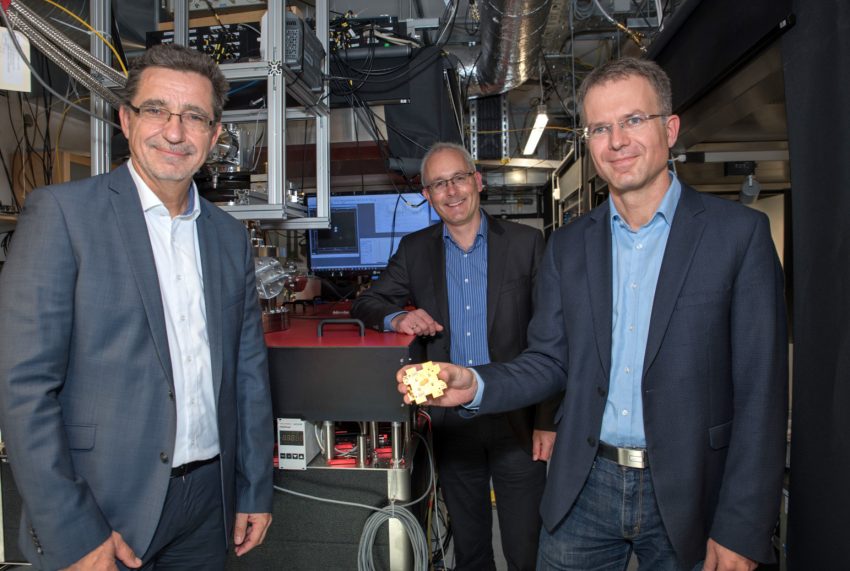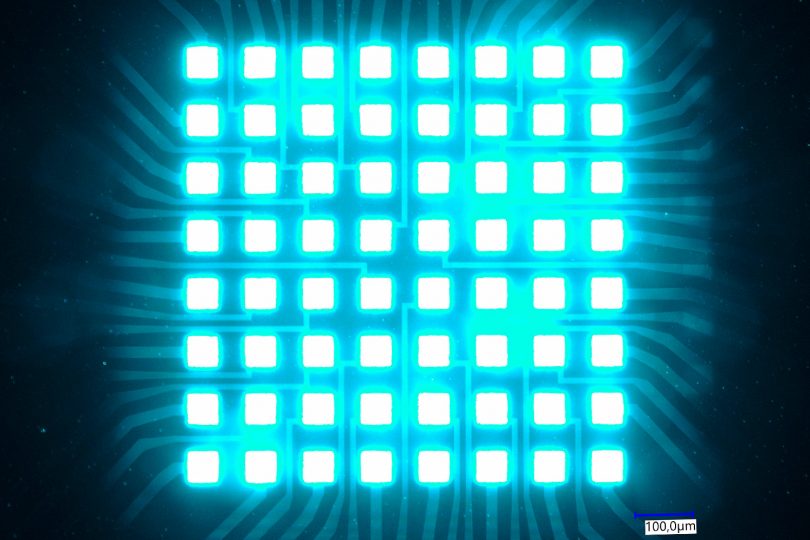A quantum computer by 2025 TU Braunschweig Member of Lower Saxony's Quantum Alliance
More than 400 scientists are pooling their expertise to develop an ion trap quantum computer by 2025 in the “Quantum Valley Lower Saxony“. With a core research area on metrology, the science of measurement, the Technische Universität Braunschweig is an essential part of the alliance with the LU Hannover and the Physikalisch-Technische Bundesanstalt in Braunschweig. Because anyone who wants to control the qubits of a quantum computer needs extreme precision.

On the way to quantum computing: (from left) Professor Andreas Waag (TU Braunschweig), Professor Piet Schmidt (PTB) and Professor Christian Ospelkaus (LUH). Picture credits: T. Dubielzig
The fact that quantum computers are considered the next technical revolution is due to the qubits. While a normal computer calculates with zeros and ones, qubits can also map all intermediate levels. When interleaved with each other, they produce the properties of a so-called neuromorphic network. This would make them similarly well networked as brain cells. For artificial intelligence (AI), applications would result that are not even imaginable today.
“We have excellent conditions in Lower Saxony to advance a quantum computer as a global pioneer. But if this technology is at the core of AI in 20 years, we must act now. We must not lose our technical sovereignty in the field,” explains Professor Andreas Waag from the Institute of Semiconductor Technology at TU Braunschweig.
However, such a qubit is extremely sensitive. As soon as it changes its state in a disordered manner, it is useless as a computing unit. How good a quantum computer is therefore depends on the error rate of the qubits. That is why the “Quantum Valley Lower Saxony” is developing an ion trap quantum computer. With Professor Christian Ospelkaus and Professor Piet Schmidt (LUH and PTB), world-leading quantum optics experts are on board for this. The ion trap approach promises stable qubits with unrivaled low error rates. The qubits consist of ions that are free-floating and sealed off in a vacuum, addressed only by lasers. The idea for the approach comes from metrology, more specifically from optical atomic clocks. There, too, researchers isolate individual ions and read out their information.
Professionals in miniaturization
Quantum computers still exist only as large, bulky laboratory setups. Even if they succeed in trapping the ions on a small chip, the rest of the lab is full of lasers, controllers and vacuum pumps. For a more compact result, the TU Braunschweig’s expertise in semiconductor and nanotechnology is needed. Piece by piece, the lab setups are to be realized on chips. A laser system will become a small semiconductor laser, the vacuum pump and the electronic control system will be miniaturized. This will continue until all the laboratory equipment has been integrated into the chip with the qubits.
However, miniaturization not only accelerates the process to market readiness and series production. It also increases the scalability of the overall structure. More qubits would then only require a few more chips and not a larger laboratory. Currently, the goal of “Quantum Valley Lower Saxony” is a quantum computer with 50 qubits by 2025, but once the quantum computer is brought into chip format, 500 or even 5000 qubits could also be realized.
Physics meets engineering
Metrological research is a core competency of the TU Braunschweig. Several factors support the construction of a quantum computer there. For example, the university is a member of the QuantumFrontiers cluster of excellence. The cluster’s scientists specialize in quantum metrological approaches, which they are now using to build a quantum computer. As a result, QuantumFrontiers has become the nucleus of the new quantum alliance in Lower Saxony.
The same applies to the Laboratory for Emerging Nanometrology (LENA). In the research center of the TU Braunschweig, physics and practical nanotechnology come together under one roof. This interdisciplinary setup is now benefiting the construction of a quantum computer. Both are needed: highly specialized quantum research and precise engineering.

